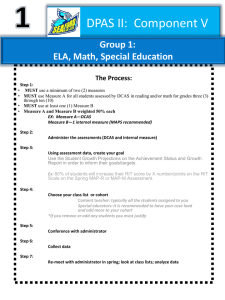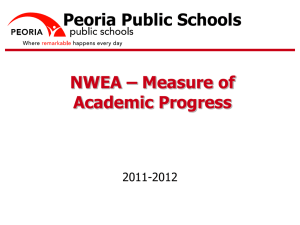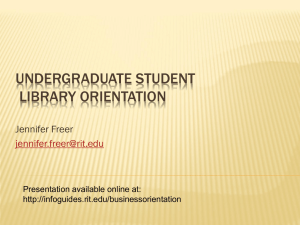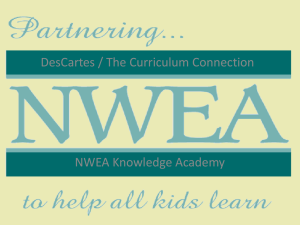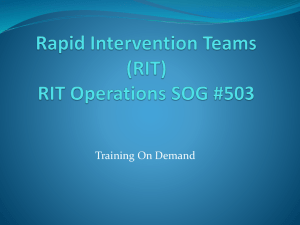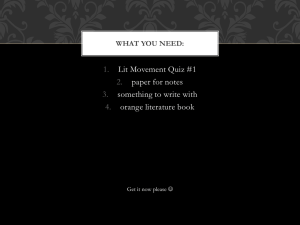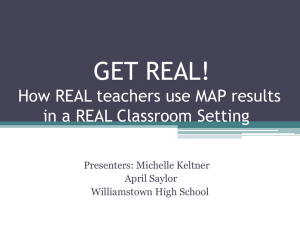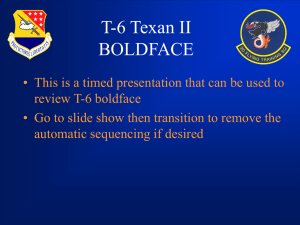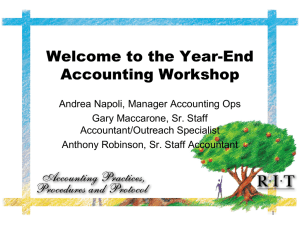Academic Portfolio Blueprint (APB) - Rochester Institute of Technology
advertisement
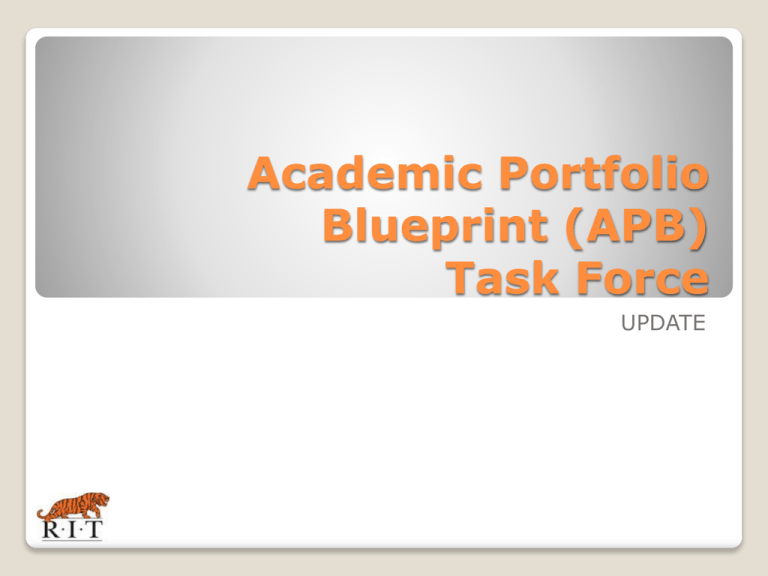
Academic Portfolio Blueprint (APB) Task Force UPDATE “Lack of formalized clarity connecting the overall portfolio of programs with the vision, mission, values and strategic direction of the institute.” The Motivation The Academic Portfolio Blueprint Task Force Carole Woodlock, co-chair College of Imaging Arts and Sciences Risa Robinson, co-chair Kate Gleason College of Engineering Ed Lincoln Enrollment Management and Career Services Manny Contomanolis Office of Co-op and Career Services Nancy Ciolek College of Imaging Arts and Sciences Zoran Ninkov College of Science Don Wilson Saunders College of Business Henry A Etlinger Golisano College of Comp and Inform Science Ferat Sahin Kate Gleason College of Engineering Heidi Miller College of Health Sciences and Technology Ann Howard College for Liberal Arts S. Manian Ramkumar College of Applied Science and Technology Gerry Bateman National Technical Institute for the Deaf The people, plans and progress Constituent Group Meeting Date Academic Senate Sept 29, Nov 3 Office of Graduate Studies Oct 11, Dec 5 President’s Round Table Oct 14 Board of Trustees Education Committee Nov 10 Graduate Council Dec 9 RIT Community: Provost’s Town Hall Dec. 12 Academic Affairs – Dr. Licata Jan 26, Golisano Inst. for Sustainability Jan 30 Global Task Force Feb 10 Office of Inclusion Diversity-K. McDonald Feb 7 Academic Affairs - Ann Whal Pending Chairs and Directors Feb 2 Faculty / Staff Tea’s Pending Dean’s Council March 20 Study Abroad co-chairs meeting weekly Center for Multidisciplinary Studies APB Task Force meets monthly (2/5 done) Inter-college Curriculum Committee multiple constituency meetings Vice President for Research University Studies Prelim draft to Dean’s Council March 20th Co-op Office Final draft to Provost April 30th Colleges Advisory groups The people, plans and progress 107 Undergraduate 95 Graduate (6 PhD) 38 Dual Degree Art Design Natural Science Social Science Humanities Business Medical Technology Related RIT’S Academic Portfolio NUMBER OF PROGRAMS 250 240 230 220 210 200 82 New Programs 190 180 170 160 150 2001 2003 2005 2007 2009 YEAR The portfolio is growing. 2011 Recommended parameters that would define the scope and domain of the Academic Profile Recommended set of criteria from which new proposals can be evaluated. Task Force Deliverables Imagine RIT Strategic Plan including mission, vision, values, guiding principals, 4 Key Result Areas (KRAs), 14 goals Academic Program Profile with guiding principals and 5 learning outcomes Self-study Areas in new Program Review Process I. Program Description (show relationship to Strategic Plan and Academic Profile) II. Program Marketability III. Program Quality IV. Program Vision Review RIT’s Guiding Documents Parameters could be defined • as enhancing synergy between different programs (Technology, Arts, Natural Science, etc.) • in support of research and scholarship (i.e. graduate versus undergraduate programs) • to maintain appropriate balance between attractor vs. retainer programs • in relation to existing, reallocation and new resources (i.e. % funded by soft money, endowment, tuition) Parameters could be described by • number programs or each type, or • relative percentage of each type, or • growth rate in particular area Potential Parameters To what extent does the proposed program support the 4 Key Result Areas? • Student success • Innovation, creativity, research and scholarship • Organizational and operational excellence • Stakeholder satisfaction To what extent does the proposed program support the Academic Profile? Specifically, the Guiding Principals of life long learning and career orientation and the 5 Program Outcomes: • Critical thinking • Global interconnectedness • Ethical reasoning • Integrative literacies • Creative innovation Potential Criteria How marketable is the proposed program with respect to enrollment, admissions, job placement, future demand? What is the quality relative to distinction of students, faculty, alumni, retention and graduation rate, employer feedback? Does the program have a reasonable cost model? Does the program fall within the parameters of the academic profile? Or would it create an imbalance relative to the blueprint parameters? Other Potential Criteria The Academic Portfolio Blueprint will provide a clear sense of whether a proposed program would be a good fit for the future RIT portfolio. The Outcome Opportunity Feedback What parameters would you like to see in the blueprint? What criteria would you like to see in the blueprint? What barriers have you encountered when proposing new programs? How do you envision the APB could remove barriers? What programs do you or would you like to have in the pipeline? Feedback The RIT Mission To provide a broad range of career-oriented educational programs with the goal of producing innovative, creative graduates who are wellprepared for their chosen careers in a global society. The RIT community engages and motivates students through stimulating and collaborative experiences. We rigorously pursue new and emerging career areas. We develop and deliver curricula and advance scholarship and research relevant to emerging technologies and social conditions. Our community is committed to diversity and student centeredness and is distinguished by our innovative and collaborative spirit. Internal and external partnerships expand our students’ experiential learning. RIT is committed to mutually enriching relationships with alumni, government, business, and the world community. Teaching, learning, scholarship, research, innovation, and leadership development for promoting student success are our central enterprises. Appendix: RIT Strategic Plan Vision RIT will lead higher education in preparing students for innovative, creative, and successful careers in a global society. Values RIT reaches the highest levels of quality of education through collective and individual commitment to ethics, pluralism, and respect for humanity. Together we value collaboration, openness, flexibility, pragmatism, experiential learning, entrepreneurship, global awareness and relationships, innovation, creativity, and practical applications. Individually, we are responsible, hard-working, critical thinkers who pursue personal and professional growth with diligence, pride, and spirit. Appendix: RIT Strategic Plan Guiding Principles 1. Students • • 2. Academics ◦ ◦ ◦ 3. 5. An RIT education will be a unique integration of high quality academic study and experiential learning, innovation, and creativity with a specific focus on successful careers. A high level of scholarship will be conducted in all academic areas to strengthen teaching and research and enhance the engagement of all undergraduate and graduate students in their learning experiences. Flexible and responsive curricula, programs, and systems will characterize the educational infrastructure. Climate and Environment ◦ 4. Providing opportunities for student success will motivate everything we do. The student climate will reflect the highest caliber of academic advising, professional counseling, caring, support, and mentoring. ◦ The campus climate will be one of openness, access, diversity, trust, mutual support, and effective communication. The university environment will reflect an aura of pride, spirit, and inclusion among all constituencies. ◦ ◦ ◦ Global awareness and experience will permeate the university. Academic and extracurricular programs will be connected and mutually reinforcing. Interdisciplinary academic programs will be encouraged. ◦ Cost effective and revenue opportunistic activities—always consistent with and supportive of the above principles and priorities—will be pursued to augment the required financial base. There will be a continual review of the cost base of the university to insure that funds are appropriately allocated to support the strategic plan. Synergy Financial Base Appendix: RIT Strategic Plan Key Result Areas 1. Be renowned for student success The extent to which students obtain an education that prepares them for the challenges and opportunities awaiting them in a rapidly changing and diverse global society. Goal 1: Improve student retention and graduation rates. Increase second-year retention rate to 93% by FY 2012. Increase graduation rate to 72% by FY 2012. Goal 2. Achieve "best in class" diversity levels for minority student, faculty, and staff populations through increasing first-year AALANA students to 14% by FY 2011; female new enrolls to 40% by FY 2015; females in tenure-track faculty positions to 32% by FY 2012; AALANA faculty in tenure-track positions to 11% by FY 2012; AALANA staff in exempt positions to 12.5% by FY 2012. Goal 3: Increase student participation in global initiatives through growing the number of international students enrolled at Rochester campus to 1800 by FY 2013; growing the number of students enrolled at RIT international sites to 1700 by FY 2013; growing the number of RIT students studying abroad to 350 by FY 2013; growing the percentage of annual coop students on global coop to 5% by FY 2013. Goal 4: Increase percentage of graduating students with employment offers or graduate school acceptances to 96% by FY 2012. Appendix: RIT Strategic Plan Key Result Areas 2. Maximize opportunities for innovation, creativity, research, and scholarship. The extent to which the educational experience is characterized by opportunities to develop and apply creative and innovative approaches to learning and problem solving. Goal 5: Provide opportunities for 100% of RIT students to experience innovation, creativity, and scholarship by FY 2013. Goal 6: Increase sponsored research awards to $90M per year by FY 2013. Goal 7: Grow RIT’s reputation in sustainability. Grow Golisano Institute for Sustainability to 40 students, 10 full-time faculty, and 20 research/extended faculty by FY 2013. Goal 8: Achieve 100% faculty participation in scholarship. Appendix: RIT Strategic Plan Key Result Areas 3. Execute with organizational/operational excellence. Achieve the organizational mission in the most cost-effective/efficient manner. Goal 9: Maintain a balanced annual operating budget. Goal 10: Achieve an endowment valued at $1B by 2015. Goal 11: Demonstrate educational excellence through the achievement of student learning, academic effectiveness, student placement goals. Meet or exceed 80% of program student learning achievement levels by FY 2013. Ensure that learning assessment results and processes guide program planning and improvement in 100% of academic programs by FY 2015. Meet or exceed academic program effectiveness goals in 90% of programs by FY 2015. Increase percentage of graduating students with employment offers or graduate school acceptances to 96% by FY 2012. Appendix: RIT Strategic Plan Key Result Areas 4. Achieve the highest levels of stakeholder satisfaction. The extent to which the requirements and expectations of key stakeholder groups are met or exceeded by RIT, including students and their families; alumni; RIT faculty and staff; business community; government; donors. Goal 12: Through brand enhancement strategies, increase undergraduate applications to 18,500 by FY 2013; out-of-state undergraduate applications to 60% by FY 2012; graduate applications to 5,500 by FY 2012. Goal 13: Increase fundraising by increasing annual fundraising to $50M by FY 2014; alumni giving to 10% by FY 2013; local and national annual donors to 20,500 by FY(??); actively engaged alumni to 35% by FY 2015. Goal 14: Achieve best-in-class stakeholder satisfaction levels by AY 2012 as measured by regularly administered faculty, staff, and student satisfaction instruments. Attain a best-in-class average overall satisfaction score on the Noel-Levitz Student Satisfaction Survey (SSI) and the National Survey of Student Engagement (NSSE). Attain a best-in-class average overall satisfaction score for graduating students on the Noel-Levitz SSI and the NSSE. Achieve a best-in-class average overall satisfaction score on the HR Solutions Employee Engagement Survey. Appendix: RIT Strategic Plan Parameters Directors and Chair Feedback Criteria Directors and Chair Feedback Barriers Directors and Chair Feedback Programs in the pipeline Directors and Chair Feedback


